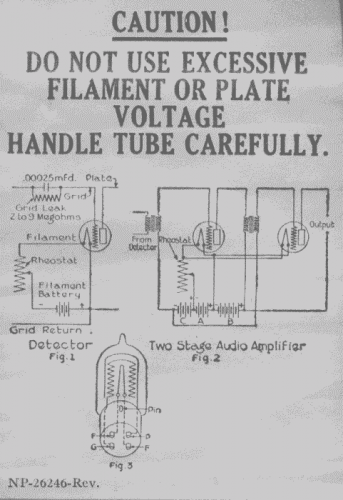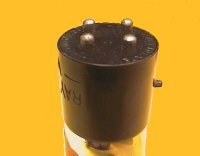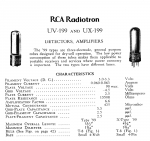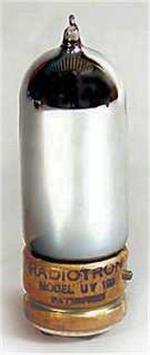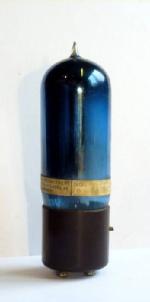|
Early development work on the UV199 tube in 1921 involved a double ended unbased tube (199_prototype) and two of these tubes were fitted into the Radio Corporation's first portable Radio Receiver in 1921. The anode was a stubby wire at one end of the tube and grid and filament wires, also stubby, were at the other end. The tube operated a the same charasteristics as the later designed (June and July 1922) single ended tube; 3.0 voltsfilament and .06 amps filament current. During
Stokes page 17: The first tubes with thoriated filament made by General Electric (GE) appeared as UV-199 and UV-201A. They were produced late in 1922 but were not available for general sale until well into 1923. The Radio models Radiola II and IV were delayed until the Christmas selling season 1922 due to shortage of UV199's.
The UV199 uses a unique small base which never was used for other tube types, except the de Forest DV3a and Western Electric 230D. The UV199 is the first tube intended for use in portable receivers as well as in home receivers using dry batteries. The filament is for 3 volts, 0.06 amperes. After a year of release this was rated to 3.3 volts. Physically the UV199 (also called 199) is much smaller than any previous GE tubes (T-8 tubular bulb). Initially a brass base was used. Tipless bulbs were introduced early in 1924 and bakelit bases came into use during October 1924.
The tubes were branded RCA, whilst being made by the General Electric Co. RCA had no manufacturing facilities until the formation of the subsidiary company, RCA Radiotron, Inc in 1930.
The tube base was redesigned to a smaller diameter UX type and the new tube was anounced in August 1925. the bulb size and shape remained the same at 1 inch (25.4 mm) diameter. In addition the new base has a characteristic reverse taper shape. The UV199 had still to be produced for replacements and to meet these needs a base adapter had been on the market for a number of years. This enabled the old UV199 based tube to fit into the adapter which then was fitted into a"large" UV or UX tube socket. With the introduction of the RCA 230 and 231 tubes in 1930, the old tubular T8 (one inch) bulb was increased to the T9, a diameter of 1&1/8th inches In 1932 UV199 and UX199 got a shoulder glass bulb and are then called V99 and X99.
After introduction of the UV199, many other manufacturers made the tube and there were a variety of type numbers such as V199, 199V, 99UV and 199. Some companies also made the tube with their own particular company "letter" prefix. Tubes were made as well, with tthe "Navy" or "large" UV base. For the tube collector, it is difficult in many instances to know these bse differences.
Text in other
languages (may
differ)
|


